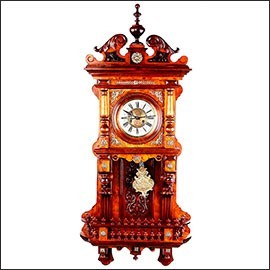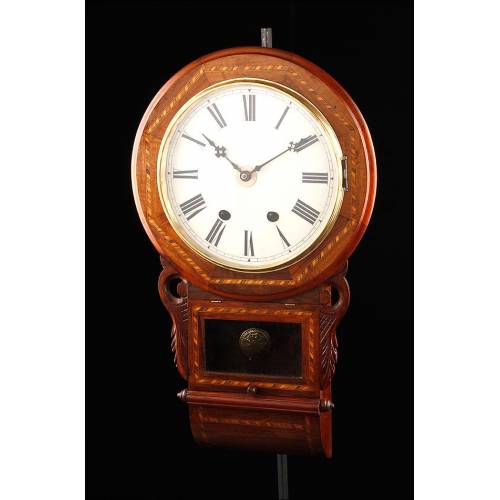Antique Wall Clocks
If all antique clocks deserve a place in the best collections, antique wall clocks stand out for their beauty and decorative potential. They are more functional than grandfather clocks, because hanging on the wall they do not take up space; moreover, their medium size allows them to be placed in virtually any corner. Antique wall clocks are des...
If all antique clocks deserve a place in the best collections, antique wall clocks stand out for their beauty and decorative potential. They are more functional than grandfather clocks, because hanging on the wall they do not take up space; moreover, their medium size allows them to be placed in virtually any corner. Antique wall clocks are designed to stand out in living rooms or entryways because of their wonderful designs and good sound. These devices are manually wound, that is, they work when the mechanism is wound or the weights are activated.
The wall clocks can be grouped by typologies, divided based on the material with which the case is made, the time and style, the mechanism, the chime ... The first wall clocks date from the invention of the pendulum machinery. The description of this system is attributed to Galileo Galilei, who wrote about it in the 19th century. However, it was Christian Huygens who built the first mechanism. The first antique pendulum clocks were large and were placed in emblematic buildings; the reduction of the size of the machinery allowed the creation of the first wall clocks, floor clocks and table clocks.
Special mention should be made of the antique wall clocks made in the Black Forest (Germany). The earliest are believed to date back to the 17th century: their dial had a single hand marking the hours. The dark wooden cases, obtained from the region's forests, were often decorated with hand-carved carvings depicting leaves, branches, acorns and other plant motifs. This design evolved, as did the mechanisms: as early as the 18th century, the first cuckoo clocks appeared, famous designs in the form of a hut with an automaton bird that strikes the hours from the upper window. The cuckoo clock business generated great wealth in the Black Forest, giving work to all kinds of craftsmen: watchmakers, carvers, cabinetmakers, painters, turners...
Types of antique wall clocks
Antique pendulum clocks. These are the most popular wall clocks, along with weight clocks. There are models that incorporate both systems. The cases used to be made of wood, usually with noble species such as mahogany, walnut or ebony. They have a front door with glass through which the pendulum can be seen. There are magnificent French, English and German models (especially from the Black Forest region), some of which include beautiful brass or bronze pendulums with hand-made reliefs. For the clock to work the pendulum must be in motion; if we want to stop the clock, it will be enough to immobilize this piece.
Antique wall clocks with Vienna type machinery. . Under this name are known wall clocks with weight mechanism. The weights hang from chains that connect them to the machinery. One of the weights operates the clock, while the other starts the hour and half-hour chime. When such a watch has three weights, the third one activates the quarter chime: this mechanism is known as the carillon.
Antique wall clocks type "porthole". . This name corresponds to the classic French and Spanish oval-shaped clocks, consisting of a large round dial surrounded by a case with marquetry and turned. They are typical of the late 19th and early 20th century. Sometimes, the dial includes precious marquetry and inlaid details made of tortoise shell, mother-of-pearl, ebony...
Antique wall clocks with complications. With the name of complications are known devices that can include a clock, apart from the dial with hours and minutes. There are wall clocks with second hand, moon phases, calendar and even complementary devices, such as barometers and thermometers.
Antique wall clocks type "mouse trap". . The name of these clocks comes from their resemblance to the mousetraps that were built when they began to be manufactured, in the mid-18th century. They originate from the German Black Forest, specifically from the Furtwagen region. Their German name is. Lackschild uhr (lack schild means "shield with paint", and uhr, clock). They consist of a square plate of lacquered wood, usually surmounted by an arch at the top. Behind the plate is hidden the mechanism, from which hang the pendulum and weights. The lacquered wood used to be delicately decorated with decals of gallant images and Roman numerals.
All these antique wall clocks are part of a universe full of charm, magic and evocative power. Collecting them can be the most passionate hobby, which will lead us to discover real gems of mechanics and decorative arts.
Attractive Solid Wood and Inlaid Wall Clock. North America, 1920-30 Attractive Solid Wood and Inlaid...
Original and decorative wall clock with inlaid ornaments, made in North America in 1920-30. Original and decorative wall clock...
Sold
New products
-

Antique ivory and silver plated stethoscope, late 19th century
Antique stethoscope from the late 19th century in silver-plated metal...
-

Vintage pendant with shell cameo of Jesús del Gran Poder, carved c. 1970
Vintage pendant with a shell-carved cameo of Jesus del Gran Poder, circa...
-

Antique Roman Style Gilded Silver Chalice with Paten. France, 1932
Antique Roman-style chalice in gilded silver with paten. France, 1932....
-

Beautiful Antique 18 K Gold Ring with 7 Natural Diamonds
Antique 18K gold ring with 7 natural diamonds. Delicate openwork design,...
-

Antique Silver Reliquary. José Vilaplana. Valencia, Spain. Circa 1920
Impressive repoussé silver reliquary by José Vilaplana, Valencia, c....
-

Vintage 18K Gold Ring with 7 Natural Diamonds
Vintage 18K gold ring with seven natural diamonds in floral setting....
-

Antique Silver Chalice. Enameled Crosses. Valencia, Spain, 1942
Spanish chalice from 1942 in solid silver, gifted by the Church of...
-

Antique Silver Chalice and Paten. Granada Spain, circa 1900
Spanish chalice in white silver with matching paten, handcrafted....
Specials
-

Antique 18K Gold Skeletonized Quarter-Repeating Verge Fusee Pocket Watch. France, 1820
Rare 18K-gold skeletonized verge...



